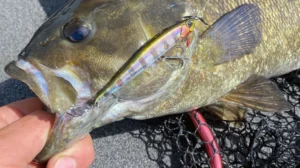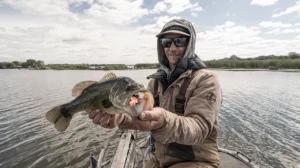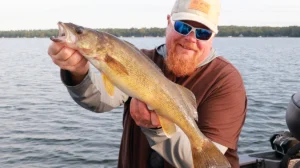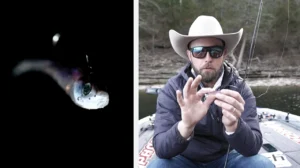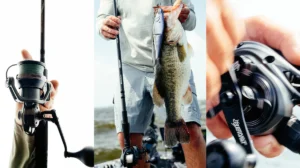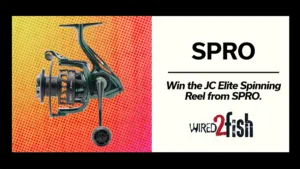When the umbrella rig hit the bass fishing world, it was widely considered the “end all, be all” of our sport. Its emergence introduced us to an entirely different thought process and allowed anglers to target bass that were previously considered uncatchable.
Times have since changed and as it turns out, the frenzy and controversy surrounding umbrella rigs has largely subsided. Despite talk of the wire and swimbait concoction losing its effectiveness overtime, it remains a viable option when targeting stubborn winter bass.
Alabama fishing guide Tim Chandler has learned to embrace umbrella rigs, especially when the weather turns cold. In order to enjoy continued success, he’s adapted his approach and figured out seven ways to increase his catch with the umbrella rig.
1. It’s not limited to deep water
Because most of the high profile tournaments dominated by the rig are won in deeper water, many of us confine our umbrella rig use to river and creek ledges, offshore shell beds and similar types of deeper bass habitat. Chandler certainly catches some nice bass in these areas, but he’s never afraid to venture to the shallows with his umbrella rig.
“The umbrella rig can be hugely effective in shallow water,” Chandler said. “Try not to limit yourself by adopting a one-track mindset. I have a lot of success with the rig in the same areas you’d throw a four to six-foot diving squarebill crankbait. It’s much more than a deep technique—it’s extremely versatile if you go outside of your comfort zone.”
After a few days of relatively warm winter weather, it’s not uncommon to see Chandler attacking shallow flats to take advantage of small increases in water temperature. It’s important to understand, however, that he doesn’t use the same setup as he would in deeper depths. Instead, he downsizes his offering to aid in fishability and castability.
“In shallow water, I’ll stick with 1/8-ounce heads on my Yumbrella Flash Mob or Yumbrella Rig,” Chandler said. “If I’m around a lot of nearby grass or other types of snag-inducing cover, I may even use a few 1/16-ounce heads to help the rig stay above any obstacles. It sounds super-lightweight, but you have to factor in the weight of your swimbaits as well. I like to use a 4-inch YUM Money Minnow on the outsides of the rig and a larger 5 1/2-inch Money Minnow in the middle.”
2. Use it to find active fish
Similar to a crankbait or lipless crankbait, umbrella rigs can be an outstanding way to find active groups of bass. Because of its larger profile, it can produce vicious reaction strikes when other presentations fall short.
“If you have at least three feet of visibility, the rig is an excellent search tool,” Chandler said. “I honestly believe if you get it within 10 feet of a bass, it’s going to eat it. Anytime you have a buddy in the back of your boat, you can find some monster schools of bass in a hurry by staggering your casts with a rig. If you can land each cast within 10 or 15 feet of your partner’s, you’ll be amazed how quickly you can cover water.”
Moving at a good clip: Chandler keeps his MotorGuide trolling motor on 6 1/2-speed while searching for active schools of bass. It may seem fast, but he believes a bass will swim a long way to eat an umbrella rig.
Whenever you get a bite while covering water, Chandler suggests slowing down and picking apart the surrounding area. Throughout the winter months, bass can get in extremely specific places—sometimes the size of a coffee table—so it’s important to switch gears and fish very methodically.
“The most aggressive fish in a school are always the most likely to bite an umbrella rig,” Chandler said. “That’s why it’s such an effective tool. I’ve seen so many times where a single bite can tip you off to the rest of the school. The less aggressive fish may not eat the rig, so it’s important to consider other options to pick up the stragglers, such as a Bomber Flat A or XCalibur Rattle Bait. If you slow down and soak the area you can get right in a hurry.”
3. Constantly experiment with your trailer selection
Many anglers believe if you throw some shad-colored swimbaits on an umbrella rig and sling it around enough, you’ll find the mother lode each time. According to Chandler, that’s not the case.
“I can’t stress the importance of constant experimentation enough,” Chandler said. “Bass can get dialed-in to the smallest, most subtle things so I’m always trying new things. Just because it’s an umbrella rig doesn’t mean you’re going to catch big bass.”
Underspins—“Replacing the middle swimbait of your umbrella rig with an underspin not only gives the rig more flash, but it also gives the appearance of an additional shad,” Chandler said. “In my opinion, the bigger shad ball you can imitate, the better off you’ll be.”Chartreuse dye—“More times than not, the trailer that stands out the most will be the first one to get bit,” Chandler said. “For this reason, I’ll dip the tail of the middle swimbait in chartreuse dye to set it apart from the others. It may not look like a big difference to the human eye, but it can really fire-up the bass.”Mix and match—“If you’re having a hard time getting bites, don’t be afraid to use a different swimbait on each wire,” Chandler said. “This will give you a great idea of the bass’ current preference. Be sure, however, to pay close attention to which swimbait the bass are eating consistently. It’s easy to toss one back without looking when your blood is pumping, but it’s very important. If you catch five bass in a row on the same swimbait, that’s a sign to change the rest of your swimbaits to match it.”
4. The bass are getting used to it
After Paul Elias caught limits of monstrous bass by chunking an umbrella rig on Lake Guntersville, hoards of anxious anglers flocked to their local fisheries to experiment with the latest craze. Sure enough, thousands of giant bass were being plucked from similar areas. It’s a bit more difficult to duplicate the rig’s early success these days, however.
“It’s not like it was three years ago by any means,” Chandler said. “You could go anywhere and catch fish on the rig after Paul won that tournament, but the bass have become accustomed to it now. When big crankbaits and buzzbaits were first introduced, people will tell you how easy it was—you could catch 100 bass every day on them. Now they’re just another tool, which is what the umbrella rig has become.”
Because of the increased fishing pressure with umbrella rigs, Chandler suggests using smaller models of the umbrella rig to catch the bass that may have become wise to the larger original models.
“You always hear about the importance of downsizing your baits when the bite gets tough,” Chandler said. “The same concept applies to the umbrella rig. If you think the fish are getting used to seeing big rigs swim by, try downsizing your whole rig. I’ve had a lot of success with the Yumbrella Flash Mob Jr. when they won’t bite the full-size model. It’s all about showing them something they may not have seen before.”
5. Bridges aren’t the only place to use them
If you visit a popular fishery such as Guntersville this time of year, you won’t find many bridges that aren’t being pounded by an umbrella rig air raid. Although bridges were hard to beat for this technique years ago, it’s not the case these days.
“After seeing the rig over and over around bridges, the bass will either totally shut off or move to a different area,” Chandler said. “I think that’s what has happened on a lot of fisheries—they saw it so much that they just up-and-left. You may be able to catch some nice ones on a bridge a few days each month, but you’re probably better off fishing elsewhere.”
An outdated theory?
Chandler believes the umbrella rig has blown the theory of light tackle in clear water out of the window. With so many people having success with the rig’s big wires and heavy braided line, he questions the theory’s merit.
In coldwater conditions, Chandler prefers to bypass bridges and search for big groups of unmolested bass. Three types of areas are especially effective—channel swings, current breaks and wood cover.
Channel swings
“Any area in which a creek or river channel swing touches shallow water is a prime target when you’re umbrella rig fishing,” Chandler said. “These areas give bass the ability to move vertically throughout the water column to feed without using too much energy. Not to mention, if a warm spell hits the area, they’re able to slide into the shallows and feed with minimal effort.”Current breaks—“Whether you have wind current or river current, current eddies can be crucial this time of year,” Chandler said. “The bass become very easy to pattern in these areas because they will face into the current in order to attack prey as it passes. If you point your boat up-current and bring your rig down current, you have a good chance of catching both quantity and quality.”Wood cover—“Wood cover is a great, failsafe option this time of year,” Chandler said. “It holds heat well and you can find it in a multitude of depth ranges. I’ll actually downsize to a 40-pound swivel on my umbrella rig so my swimbait will break off instead of my entire rig if I get hung.”
6. Doing something different with your retrieve
Whether we’re throwing a crankbait, spinnerbait or an umbrella rig, so many of us get into “zombie mode” when we’re using reaction baits. When you fish for a few hours without many bites, it can get tempting to stare off into space—it happens to everyone. Chandler advises against this, as he believes fishing an umbrella rig is a big mental commitment.
“There are times you can straight-reel an umbrella rig and catch fish, but you’ll have a lot more success if you can actively fish it and constant adjust your retrieve,” Chandler said. “A large majority of my bites come after I do something different to entice a reaction strike. There’s always a trigger mechanism within a bass that you have to figure out each day. Something will make them bite.”
Adjusting your retrieve not only takes advantage of a bass’ natural predatory instinct, but similar to trailer experimentation, also helps you develop a more solid game plan. Whether you’re stopping your rig periodically, speeding it up or simply popping your rod tip, pay close attention to your bites. If you get a few bites on a specific retrieve, you’ll probably be able to duplicate your success throughout the entire day.
7. Additional customizations to consider
Since the umbrella rig’s inception, Chandler has spent a lot of time tinkering and developing ways to fool pressured bass and make it more user-friendly. His practical and inexpensive customization ideas have resulted in a lot of big bass catches.
Recommended gear:
- 6.5:1 gear ratio Shimano Curado Casting Reel
- 80-pound Sunline FX2 Braided Line
- 7-foot, 6-inch heavy-action Falcon BuCoo Micro Guide Casting Rod
- O-rings
“Umbrella rigs are notorious for being difficult to store,” Chandler said. “For both boaters and co-anglers alike, they can be quite cumbersome. To help with that, I go to the plumbing store and buy O-rings about the diameter of a dime and put them between the head and wires of the rig. It doesn’t impede the action whatsoever, but when you’re ready to store your rods, you can slide that ring down to collapse the wires. It doesn’t bend the wires, so you don’t have to worry about any type of metal fatigue.”Jig skirt—“I’ve recently started putting a jig skirt behind the head of some of my umbrella rigs,” Chandler said. “It gives the head a spinnerbait-type appearance, which gives the bass something extra to hone-in on.”Small wire spread—“I get a lot of questions regarding the spread size of my umbrella rig wires,” Chandler said. “I’ve tried it all and I really believe a smaller spread gets more bites than a larger one. If you just barely bend the wires outward so the swimbaits have enough room to move freely, you’ll be able to catch more fish.”
The next time you go fishing, consider these simple tips before throwing your umbrella rig. Sure, the action may have slowed down since its introduction, but a few small adjustments can make a monumental difference.
How has the umbrella rig bite been on your fishery lately? Have you noticed a decline in the number or quality of bass?




![[VIDEO] McClelland’s Top 7 Winter Bass Baits Explained](https://www.wired2fish.com/wp-content/uploads/2024/12/winter-bass-fishing-lures-300x169.webp)


